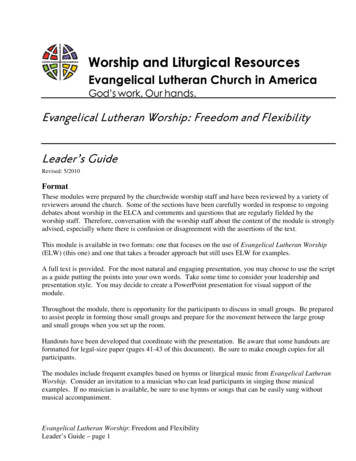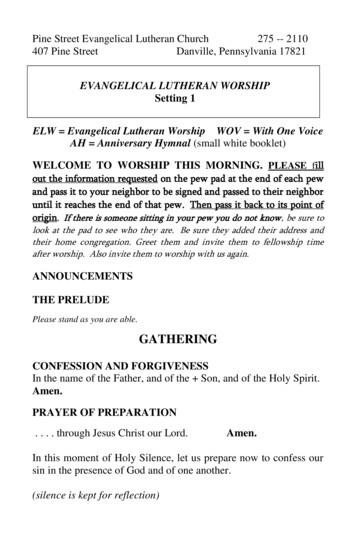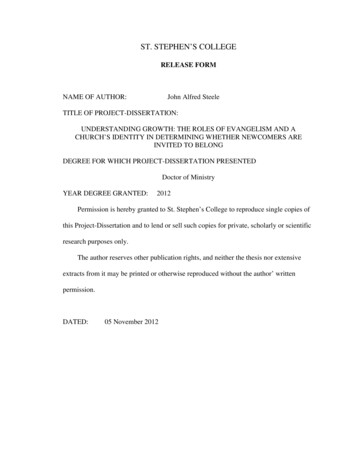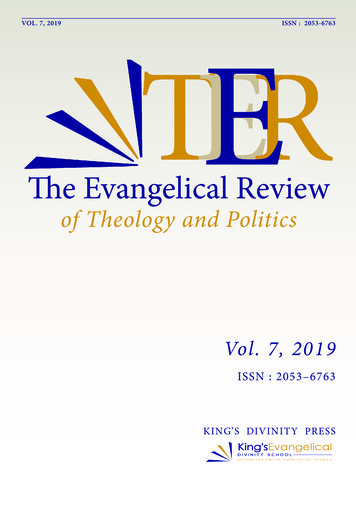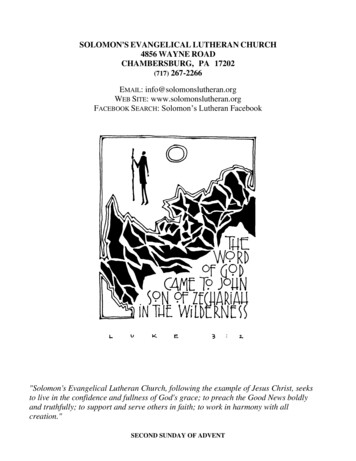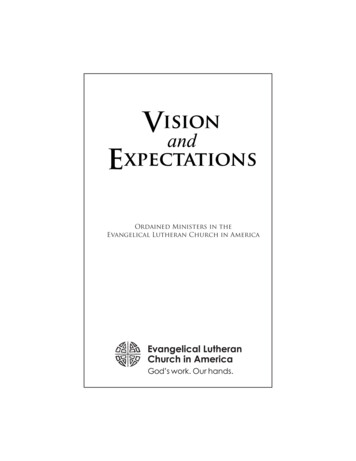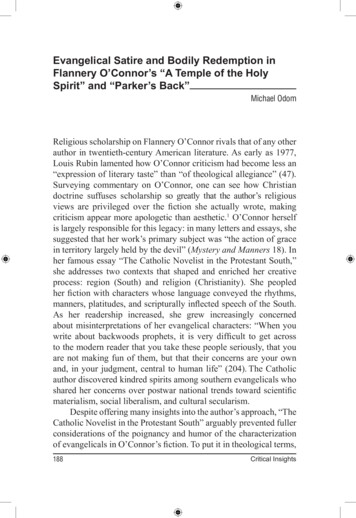
Transcription
Evangelical Satire and Bodily Redemption inFlannery O’Connor’s “A Temple of the HolySpirit” and “Parker’s Back”Michael OdomReligious scholarship on Flannery O’Connor rivals that of any otherauthor in twentieth-century American literature. As early as 1977,Louis Rubin lamented how O’Connor criticism had become less an“expression of literary taste” than “of theological allegiance” (47).Surveying commentary on O’Connor, one can see how Christiandoctrine suffuses scholarship so greatly that the author’s religiousviews are privileged over the fiction she actually wrote, makingcriticism appear more apologetic than aesthetic.1 O’Connor herselfis largely responsible for this legacy: in many letters and essays, shesuggested that her work’s primary subject was “the action of gracein territory largely held by the devil” (Mystery and Manners 18). Inher famous essay “The Catholic Novelist in the Protestant South,”she addresses two contexts that shaped and enriched her creativeprocess: region (South) and religion (Christianity). She peopledher fiction with characters whose language conveyed the rhythms,manners, platitudes, and scripturally inflected speech of the South.As her readership increased, she grew increasingly concernedabout misinterpretations of her evangelical characters: “When youwrite about backwoods prophets, it is very difficult to get acrossto the modern reader that you take these people seriously, that youare not making fun of them, but that their concerns are your ownand, in your judgment, central to human life” (204). The Catholicauthor discovered kindred spirits among southern evangelicals whoshared her concerns over postwar national trends toward scientificmaterialism, social liberalism, and cultural secularism.Despite offering many insights into the author’s approach, “TheCatholic Novelist in the Protestant South” arguably prevented fullerconsiderations of the poignancy and humor of the characterizationof evangelicals in O’Connor’s fiction. To put it in theological terms,188Critical Insights
scholars heeded O’Connor’s metacommentary as orthodoxy, so thatcounter-interpretations run the risk of seeming heretical. I see twoproblems that need to be addressed here. First, it is easy to conflateO’Connor’s imaginative prose and her retroactive commentary onher stories, forgetting that these are two very different things. WhileO’Connor certainly knew what she was doing as an artist, she hardlyintended her commentary to be received as definitive criticism ofher work.2 I agree with Harold Bloom’s suspicion that the theologyimplied in O’Connor’s fiction is often quite different from whatthe author herself thought it to be (4). Furthermore, O’Connor’ssympathy for southern evangelicals need not imply an absence ofcritique.Evangelical Christianity has singularly dominated theAmerican South, establishing a cultural hegemony that shapedthe region’s social and political views from the nineteenth centuryforward. Assuming the inerrancy of scripture, evangelical theologystresses human sinfulness and the need for redemption achievedthrough Christ’s atonement, appropriated by individual faith,and accompanied by personal morality. This individualist streakamong evangelicals devalued churches, sacraments (especiallythe Eucharist), the human body, and social institutions. Indeed, theevangelical milieu of O’Connor’s native Georgia afforded plentyfor her to satirize. My essay, therefore, will highlight satire onevangelicalism in two of her stories, “A Temple of the Holy Ghost”and “Parker’s Back,” in which destructive views of the human bodyare reconfigured through unexpectedly sacramental means.Both stories employ taboo bodily manifestations to correctevangelical sensibilities that devalue human flesh.3 “A Templeof the Holy Ghost” makes a hermaphrodite at a local fair beardrastic witness to obedience to God’s will, invoking a sacramentaltheology teaching that human corporeality, no matter how strangeor deformed, envelops the indwelling Holy Spirit. The freak show isreconstructed through the imagination of a precocious twelve-yearold girl who dreams of the hermaphrodite leading an evangelicalrevival complete with traditional call and response preaching.The preaching she imagines urges congregants to honor God withEvangelical Satire and Bodily Redemption189
their bodies, which are temples of the Holy Spirit. Despite thehermaphrodite’s biblical summons, however, the exhibition provestoo risqué for local evangelical pastors, who have the police shutdown the entire fair because its indecency shocks their sensibilities.O’Connor also provides comically insightful contrasts betweenmodern evangelical hymns and their ancient Catholic counterparts.Meanwhile, “Parker’s Back” dramatizes the conversion of a sensualtattoo enthusiast who eventually resembles the prophet—Obadiah—after whom he is named. O’Connor contrasts her protagonist’ssacramental tattoos with his wife’s “straight gospel” theology,which eschews all physical signs as idolatrous. With their sharedemphasis on the human body, both stories exemplify O’Connor’soblique treatment of human sexuality in her fiction.“A Temple of the Holy Ghost” comprises the most explicitCatholic narrative in O’Connor’s entire oeuvre. Set in the fictionalrural town of Mayville, the story inhabits the perception of a nameless,twelve-year-old girl who, along with her mother, hosts her twofourteen-year-old cousins, Susan and Joanne, during their weekendgetaway from Catholic school. The ages of the girls—all Catholic—emphasize the story’s prevailing themes of adolescence, chastity, andthe relevance of religion to everyday life. The protagonist watchesas her older cousins arrive and immediately discard their brownconvent uniforms in favor of red skirts, “loud blouses,” lipstick, andhigh heels. The girls then take turns prancing in front of a hallwaymirror, admiring their budding sexuality. Obsessed with boys andclothes, they ridicule the religious teachings exhorting them to shunsexual immorality (O’Connor, The Complete Stories 238; hereafterCS). The story’s title is first mentioned when the cousins explain,over dinner, how Sister Perpetua, the convent’s oldest nun (who isnamed after a prominent third-century female martyr), instructedthem to ward off sexual advances in the backseats of automobilesby saying, “Stop sir! I am a Temple of the Holy Ghost!” (238). Infact, the cousins mockingly call themselves Temple One and TempleTwo, showing their disdain for the convent’s teachings about theHoly Spirit’s indwelling in the human body as the basis for sexualpurity. Despite the cousins’ giggling interjections, the young girl190Critical Insights
finds this discussion no laughing matter. She is transfixed by thetraditional teaching the girls reject: “I am a Temple of the HolyGhost, she said to herself, and was pleased with the phrase. It madeher feel as if somebody had given her a present” (238).The precocious girl plans to entertain her shallow cousinsby suggesting that Wendell and Cory Wilkins, two farm boys andaspiring Church of God preachers, escort them to the local fair. Thegirl thinks the Wilkins boys are perfect matches for her cousins:they are sixteen, drive an automobile, and are similarly religiouslyignorant: “They were both going to be Church of God preachersbecause you don’t have to know nothing to be one” (CS 239). Whilethis withering observation highlights the young girl’s pride, it alsosatirizes the ease with which evangelicals heed the “call” to ministrywith little examination or evidence of qualification. The narrativeunderscores this idea further when physically describing the boys:“They sat like monkeys, their knees on a level with their shouldersand their arms hanging down between. They were short thin boyswith red faces and high cheekbones and pale seed-like eyes” (240).As they sit with Susan and Joanne, the boys display an evangelicalpenchant for sentimental music that fuses popular regional soundswith old time religious hymns:They had brought a harmonica and a guitar. One of them beganto blow softly on the mouth organ, watching the girls over it, andthe other started strumming the guitar and then began to sing, notwatching them but keeping his head tilted upward as if he were onlyinterested in hearing himself. He was singing a hillbilly song thatsounded half like a love song and half like a hymn . Wendell beganto smile as he sang and to look at the girls. (CS 240)O’Connor understood how centrally evangelical Christianityused music to draw in audiences with familiar, sentimental sounds.The narrator satirizes Wendell’s contrived attempts to entice the girlswith his “dog-like loving look” (CS 240). As the boys commencesinging “The Old Rugged Cross,” the girls interrupt and mockinglysing in Latin the Tantum Ergo—the famous medieval RomanCatholic Benediction of the Blessed Sacrament composed byEvangelical Satire and Bodily Redemption191
Thomas Aquinas. It venerates the mystery of Christ’s body as the hostupon which believers feast in the sacrament. The juxtaposition of aubiquitous evangelical hymn alongside an ancient Latin benedictionmight seem an ecumenical gesture, uniting evangelicals andCatholics by emphasizing the common features of their worship ofChrist crucified. However, upon closer inspection, the juxtapositionactually satirizes the narcissism and sentimentality reflected in thehymn. Written by Methodist evangelist George Bennard in 1913 andpopularized during the revivals of Billy Sunday, “The Old RuggedCross” was composed to fit the familiar country music verse-choruspattern. It embodied both the adaptability and rugged individualismof American Protestantism. Bennard penned the hymn during a lowpoint when he was heckled and ridiculed during revival meetings; hismistreatment helped him identify with the burden Christ must havefelt while carrying the cross that bore humanity’s sins. Ostensibly,the hymn honors the sacrifice of Christ’s body on the cross for theforgiveness of sins; in reality, it celebrates the speaker’s courage,constantly employing first-person speech. In this hymn, Christ’sbody is an afterthought to the speaker’s own “ever true” response tothe cross he so “loves, cherishes, clings [to], lays down, exchanges,gladly bears, and shares” (Baxter 6).When confronted with the Latin Tantum Ergo, which rightlyadores the sacred host while asking for faith to supplement feeblehuman senses—a striking contrast to their very American hymn tohuman effort and mobility—Wendell retorts, “That must be Jewsinging” (CS 241). The young girl, hiding nearby, cannot restrainherself: she shouts, “You big dumb Church of God ox!” (241). Whileher outburst displays her sense of superiority and frustration withthe ignorance of the evangelical boys, O’Connor’s use of animalimagery as insult aptly alludes to Aquinas, who was nicknamed “thedumb ox” for his large size and reticent manner by his peers at theUniversity of Cologne. Aquinas’s mentor, the celebrated Dominicansaint and scholar, St. Albert the Great, famously declared that thedumb ox’s teaching would eventually “produce such a bellowing thatit will one day be heard throughout the world” (Stump 3). O’Connor’sallusion suggests that the young girl may also be shortsighted about192Critical Insights
the future of these evangelicals as potential ministers. Her disdainfor evangelical simplicity and sensationalism is further displayedwhen she mocks a Baptist preacher who had visited her school togive a devotional. Drooping her mouth and holding her forehead asif in agony, she ridicules his benediction by groaning, “Fawther, wethank Thee” (CS 243).While the girl possesses perceptive theological instincts, herprecociousness cuts both ways, as the narrator makes clear: “Shedid not steal or murder but she was a born liar and slothful and shesassed her mother and was deliberately ugly to almost everybody.She was eaten up also with the sin of Pride, the worst one” (CS 243).Even her bedtime prayers reflect her smug superiority: she thanksGod repeatedly that she’s not in the Church of God like Wendelland Cory. As in many O’Connor stories, her means of grace comesfrom an unlikely source: the two cousins return late that night to tellabout a freak show at the fair. The cousins describe a hermaphroditein a blue dress walking back and forth on each side of a circus tentdivided by a black curtain to separate the men and women. Uponentering each side, the hermaphrodite lifts a blue dress to reveal bothmale and female sexual organs while boldly declaring:God made me thisaway and if you laugh He may strike you the sameway. This is the way He wanted me to be and I ain’t disputing His way.I’m showing you because I got to make the best of it. I expect you toact like ladies and gentlemen. I never done it to myself nor had a thingto do with it but I’m making the best of it. I don’t dispute hit. (CS 245)The startling imagery of double genitalia alludes to the scripturalcontext of the story’s title. In the New Testament, the Apostle Paulwrites to the Corinthians concerning sexuality and the body, urgingthem to flee immorality; he contends that sexual union between twopeople, “joined in the flesh,” should reflect the spiritual redemptionby which they were justified in Christ’s name and through thesubsequent indwelling of the Holy Spirit. By declaring humanbodies are intended for the Lord, not fornication, Paul grounds hisargument in the mystical union between Christ and his church:Evangelical Satire and Bodily Redemption193
Know ye not that your bodies are the members of Christ? Shall Ithen take the members of Christ, and make them the members of anharlot? God forbid. What? Know ye not that he which is joined to anharlot is one body? For two, saith he, shall be one flesh. But he thatis joined unto the Lord is one spirit. Flee fornication. Every sin thata man doeth is without the body; but he that committeth fornicationsinneth against his own body. What? Know ye not that your body isthe temple of the Holy Ghost which is in you, which ye have of God,and ye are not your own? (1 Corinthians 6:15–19 KJV)This “two become one flesh” doctrine is first mentioned in Genesis2:24 and reinforced throughout the New Testament by Jesus(Matthew 19:5 and Mark 10:8) and Paul (again in Ephesians 5:31).The hermaphrodite, by possessing male and female genitalia, is aprofane sacramental vessel illustrating a sacred doctrine. DeniseAskin keenly notes how the hermaphrodite might also function asa “parodic reflection of the hypostatic union defined by the Councilof Chalcedon, a mystery of the true union of two full natures withneither of them compromised—the scandal of the God-made-man”(563).As the young girl later processes the freak show’s meaning, sheimagines the faces of the country people watching the hermaphroditewith a solemnity more profound than they would display evenin a church. This imagined voyeurism seems appropriate to theyoung girl, who has been cast as an isolated watcher of what goeson around her. Her imaginative reconstruction of the freak showresembles the deep evangelical features of a Holiness-Pentecostalworship service, with its hymns, beats, clapping, and signature calland-response preaching style. The child’s imagination emphasizesthe story’s central theological message:God done this to me and I praise Him.Amen. Amen.He could strike you thisaway.Amen. Amen.But he has not.Amen.194Critical Insights
Raise yourself up. A temple of the Holy Ghost. You! You are God’stemple, don’t you know? Don’t you know? God’s Spirit has adwelling in you, don’t you know?Amen. Amen.If anybody desecrates the temple of God, God will bring him to ruinand if you laugh, He may strike you thisaway. A temple of God is aholy thing.Amen. Amen.I am a temple of the Holy Ghost.Amen. (CS 246)The girl spiritually augments her earlier musings on the bodybeing the temple of the Holy Spirit. She sees the hermaphrodite’sacceptance of circumstances—and his vocational proclamationof such circumstances—as part of the divine plan. Ironically, thesources of both ideas (the body being a temple of the Holy Ghost andthe hermaphrodite’s freak show) are the fourteen-year old cousinswho ridicule both concepts. Such irony underscores O’Connor’ssacramental vision of God’s grace being present throughout theempirical universe; the young protagonist possesses the eyes to seeand ears to hear the summons awaiting her at the story’s conclusion.Indeed, O’Connor recalls these very elements at the climacticending, when the protagonist and her mother return the two cousinsto the convent on Sunday. Upon arriving, they are greeted by a“moon-faced nun”—a reflection of the sun (or Son)—who ushersthem into a chapel just as the Tantum Ergo benediction is given forEucharist. When the girl beholds the priest kneeling in front of themonstrance, she realizes she is “in the presence of God” (CS 247).When the priest raises the monstrance with the Host shining in itscenter, her thoughts return to “the tent at the fair that had the freakin it” (248). Like the monstrance, the hermaphrodite symbolizes themystical union of body and spirit, human and divine. Of course,not everyone can see the hermaphrodite as sacramental vessel: localevangelical preachers inspect the freak show and have the policeshut it down (248).Because of its originality and theological sophistication, “ATemple of the Holy Ghost” is one of O’Connor’s best works. YetEvangelical Satire and Bodily Redemption195
for all the violence and disturbing imagery she famously employedto shock the allegedly dull sensibilities of a post-Christian readingaudience, I find the oblique treatment of sexuality in her fiction—particularly in a story devoted to the very topic—puzzling. WhileO’Connor lacked much personal sexual experience, the same canbe said of many other experiences (like violence and murder) sheemphasizes. While her fiction does contain some unsettling sexscenes, involving a grotesque prostitute (Wise Blood) and rape (TheViolent Bear It Away), these moments pale in comparison to herexplicit depictions of violence. Reciprocated romance is unusual inher fiction, even in a rare scene involving seduction (“Good CountryPeople”). This absence of romantic sexuality, acknowledged byO’Connor herself, was intentional, not accidental. She explicitlynoted how “A Temple of the Holy Ghost” was concerned withsexual purity (or abstinence), “the most mysterious of the virtues,”and argued that purity involves embracing “what God wills for us,an acceptance of our individual circumstances” (The Habit of Being117, 124; hereafter HB).O’Connor thought purity must be grounded in the mystery ofthe Eucharist—the Catholic belief that the Host is “actually the bodyand blood of Christ, not a symbol” (HB 124). “A Temple of the HolyGhost” explicates her belief in the sacrament as the embodiment ofhuman existence, making all else “expendable” (HB 125). As lateas 1962, she wondered why the story had not been anthologizedor received much critical attention (HB 487). Fifty years later, weshould all be wondering the same.Like “A Temple of the Holy Ghost,” “Parker’s Back” exploressexuality and the human body within the context of the evangelicalSouth; however, instead of offering Catholicism as an alternativeto the region’s un-sacramental tendencies, the author dramatizesthe conversion of a sensualist and the subsequent navigation of hisnewfound vocation as a prophet within the destructive confines ofhis wife’s fundamentalist theology. “Parker’s Back” was the laststory O’Connor would write before her untimely death. Whileshe here again addressed the familiar subject matter of Christian196Critical Insights
redemption through violence, she also tackled new material with atattoo enthusiast as her protagonist.O’Connor employs the carnival tent in “Parker’s Back,” asshe did in “A Temple of the Holy Ghost,” to function as a secularsurrogate for church. At the age of fourteen, Parker experiences anepiphany upon seeing a man covered from head to toe in tattooswith only his loins girded in panther hide. The tattoos radiate a“single intricate design of brilliant color,” creating an “arabesque ofmen and beasts and flowers on his skin,” which possesses a “subtlemotion of its own” (CS 512–13). The scene resonates with Parker,leaving his mouth agape as he lingers in the empty tent long afterthe show concludes. The narrator conveys his experience throughthe language of religious conversion: “It was as if a blind boy hadbeen turned so gently in a different direction that he did not knowhis destination had been changed” (513). Parker demonstratesan inherent religious wisdom about tattoos and their connectionto suffering upon receiving his first one: “It hurt very little, justenough to make it appear to Parker to be worth doing. This waspeculiar too for before he had thought that only what did not hurtwas worth doing” (513). Tattoos also signify his quest for sensualpleasure. Endowed with a sixth sense “that told him when there wasa woman watching him,” Parker thinks that his alluring skin helpsmake him seductive (511). With each sexual conquest, his conceitincreases. His tattoos of fierce animals reveal his lust for life andcolor; conversely, the tattoos reveal an emptiness underneath, forwhen the novelty of a tattoo wears off, Parker’s dissatisfaction withlife reemerges as if “the panther and the lion and the serpents and theeagles and the hawks had penetrated his skin and lived inside him ina raging warfare” (514).Despite a vow to “never get tied up legally,” Parker’s pride getsthe better of him when he encounters an indifferent fundamentalist(CS 511). Sarah Ruth is introduced when Parker’s truck breaks downnear her house. She somehow intrigues Parker when she disdains histattoos, for he “had never yet met a woman who was not attractedto them” (512). Perpetually “sniffing up sin,” she rejects smoking,dipping tobacco, drinking whiskey, using profanity, using makeup,Evangelical Satire and Bodily Redemption197
and driving. When she first inspects the tattoos on Parker’s arm,she drops his hand “as if she had accidentally grasped a poisonoussnake” (512). This striking biblical allusion to the Genesis accountof original sin intimates how she will undoubtedly add tattoos to agrowing litany of other sins she fondly externalizes. The evangelicaltendency to externalize vice conveniently reduces the complexity ofsin, which actually resides in the human heart, not in bars or tattooparlors. Her impassioned condemnations make Parker wonderwhy she would marry someone like him, who literally embodieswhat she hates: “Sometimes he supposed that she had married himbecause she meant to save him. At other times he had a suspicionthat she actually liked everything she said she didn’t” (510). The lastsentence insightfully suggests that fundamentalists’ strictures oftenshroud a suppressed desire for the very sins they revile.O’Connor contrasts the puritanical wife and the tattooedprotagonist: Parker’s sensuality suggests his predisposition toa deeper appreciation of the empirical world. Sarah Ruth’s skinappears plain, thin, and tight, in contrast to her husband’s scintillatingskin. Similarly, her gray-colored eyes appear sharp, like icepicks,implying a simplistic, black-and-white, judgmental outlook on theworld. Parker’s eyes, on the other hand, display “the same paleslate-color as the ocean and reflected the immense spaces aroundhim as if they were a microcosm of the mysterious sea” (CS 514).While Parker’s expansive vision enables him to seek adventure andappreciate complexity, it also frightens him, making him embrace theparochialism that comes so naturally for Sarah Ruth: “Long viewsdepressed Parker. You look out into space like that and you beginto feel as if someone were after you, the navy or the government orreligion” (516).O’Connor’s characterization of Sarah Ruth satirizes theevangelical penchant for ahistorical, disembodied religiosity. Thecouple marries in the County Ordinary’s office “because SarahRuth thought churches were idolatrous” (CS 518), and she similarlyregards Parker’s tattoos, like makeup and anything pictured on theskin, as the “vanity of vanities” (518). Parker incorrectly speculatesthat Sarah Ruth might enjoy a tattoo if it were religious and positioned198Critical Insights
on his back, a location he perceives as linked with self-renunciation.He becomes increasingly preoccupied with some unknown mystery,which breaks him of his self-conscious concern over appearanceand what others might think. As his dissatisfaction grows, the ideaof a back tattoo becomes irresistible. He first considers having theHoly Bible or a verse from scripture tattooed on his back beforeimagining Sarah Ruth’s objections: “Ain’t I already got a real Bible?What you think I want to read the same verse over and over forwhen I can read it all? He needed something better even than theBible!” (519). Envisioning something superior to the Bible would beunthinkable for evangelicals, who champion the divine inspirationof the written word above all else. But O’Connor’s narrative revealshow over-emphasizing the written word can mean neglectingChristianity’s most essential doctrine: God taking on human flesh.O’Connor depicts the consequences of such disembodied religionby describing Sarah Ruth’s preparation of food: she simply tossesingredients in a pot and boils them, and her indifference to empiricalfacts leads to Parker’s malnourishment and loss of literal flesh.O’Connor further highlights the importance of embodied faithby describing violent encounters and visible signs of grace breakinginto the ordinary. In a clear allusion to the Apostle Paul’s conversionexperience (Acts 9:1–9), Parker experiences his own vision oneday at work while riding a tractor. When he crashes into a treethat bursts into flames, he yells, “GOD ABOVE!” In addition toemploying this burning bush imagery (Exodus 3:2), the narrative atthis point repeatedly uses the terms “back” and “backward,” alongwith the sign of the cross and Parker collapsing to his knees, toconnote conversion. Parker immediately heads to the city to seal hisconversion with a tattoo, knowing that “there had been a great changein his life, a leap forward into a worse unknown, and that there wasnothing he could do about it. It was for all intents accomplished”(CS 520–21). Arriving at the tattoo parlor, he asks to see sketches ofGod. The artist informs him that the “up-t-date ones are in the back.”The up-to-date images—“The Good Shepherd, Forbid Them Not,The Smiling Jesus, Jesus the Physician’s Friend”—comically depictthe evangelical ethos of adapting Christ to modern sensibilities. YetEvangelical Satire and Bodily Redemption199
Parker, who has just experienced religious conversion, continuesto flip backward to less assuring pictures. Again repeating the termback, the voice of God tells Parker (just as he passes a picture witha pair of eyes glancing swiftly and severely) to “GO BACK.” There,Parker sees a “haloed head of a flat stern Byzantine Christ withall-demanding eyes. [Parker] sat there trembling; his heart beganslowly to beat again as if it were being brought to life by a subtlepower” (522). His tattoo embodies a return to ancient, incarnationalChristianity and all its representational qualities; the image of thestern Christ possesses “eyes to be obeyed” (527).As O’Connor concludes the story, her use of Christian imagerybecomes more heavy-handed. Parker drinks a pint of whiskey ina back alley and enters a pool hall where he starts a fight whenlocals poke fun at his new tattoo, only to be tossed out like “Jonahhad been cast into the sea” to take up his vocation as unwillingprophet (CS 527). The allusions to prophets continue when hereturns home to Sarah Ruth, who won’t allow him to enter untilhe speaks his baptismal name, “Obadiah Elihue.” Doing so makeshim feel “light pouring through him, turning his spider web soulinto a perfect arabesque of colors, a garden of trees and birds andbeasts” (528). When he shows Sarah Ruth the tattoo of Christ on hisback, she retorts (alluding to John 4:24) that God is a spirit whoseface no man shall behold. Condemning idolatry, she beats Parkersenseless, creating large welts on the tattooed face of Christ. Thestory concludes with Parker, clinging to a tree, weeping like a baby.The final persecution scene reveals O’Connor’s judgment of SarahRuth’s Protestant overcorrection.After reviewing early drafts of the story, Caroline Gordon toldO’Connor that she had succeeded in dramatizing a heresy in hercharacterization of Sarah Ruth. O’Connor concurred, noting thatSarah Ruth commits heresy by subscribing to the belief that onecan worship in pure spirit (HB 593–93). Parker’s story is an adultconversion experience of a troubled soul. His sensualistic pursuitsand wanderings, epitomized by his tattoos, impulsive joining of theNavy, hard drinking, and womanizing all suggest a soul starved forspiritual sustenance. “Parker’s Back” leads readers to anticipate200Critical Insights
Parker’s future vocation as a southern prophet—a motif explored inother O’Connor stories.Because O’Connor’s characters are so clearly drawn, readersfamiliar with southern religious culture (as opposed to unfamiliar,secular readers) will recognize her evangelicals as more real thanexaggerated. O’Connor resisted the temptation to use imaginativefiction to make religious faith more easily appealing. She onceacknowledged this temptation when addressing complaints fromChristians that her fiction was too disturbing and did not present theirfaith more positively:Ideal Christianity doesn’t exist, because anything the human beingtouches, even Christian truth, he deforms slightly in his own imagealways toward the abstract and therefore toward allegory, thinness,and ultimately what they are looking for is apologetic fiction. Thebest of them think: make it look desirable so I won’t look like a foolfor
If anybody desecrates the temple of God, God will bring him to ruin and if you laugh, He may strike you thisaway. A temple of God is a holy thing. Amen. Amen. I am a temple of the Holy Ghost. Amen. (CS 246) The girl spiritually augments her earlier musings on the body being the temple of the Holy Spirit. She sees the hermaphrodite's



